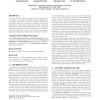Free Online Productivity Tools
i2Speak
i2Symbol
i2OCR
iTex2Img
iWeb2Print
iWeb2Shot
i2Type
iPdf2Split
iPdf2Merge
i2Bopomofo
i2Arabic
i2Style
i2Image
i2PDF
iLatex2Rtf
Sci2ools
ASSETS
2006
ACM
2006
ACM
Improving non-visual web access using context
To browse the Web, blind people have to use screen readers, which process pages sequentially, making browsing timeconsuming. We present a prototype system, CSurf, which provides all features of a regular screen reader, but when a user follows a link, CSurf captures the context of the link and uses it to identify relevant information on the next page. CSurf rearranges the content of the next page, so, that the relevant information is read out first. A series experiments have been conducted to evaluate the performance of CSurf. Categories and Subject Descriptors H.5.2 [Information Interfaces and Presentation]: User Interfaces—natural language, Voice I/O; H.5.4 [Information Interfaces and Presentation]: Hypertext/Hypermedia— architectures, navigation; H.3.3 [Information Systems]: Search and Retrieval General Terms Algorithms, Design, Human Factors, Experimentation Keywords Web Navigation, Context, Assistive Device, Screen-Reader, Voice Browsing, User Interface, CSurf, Non-Visual, In...
| Added | 13 Jun 2010 |
| Updated | 13 Jun 2010 |
| Type | Conference |
| Year | 2006 |
| Where | ASSETS |
| Authors | Jalal Mahmud, Yevgen Borodin, Dipanjan Das, I. V. Ramakrishnan |
Comments (0)

